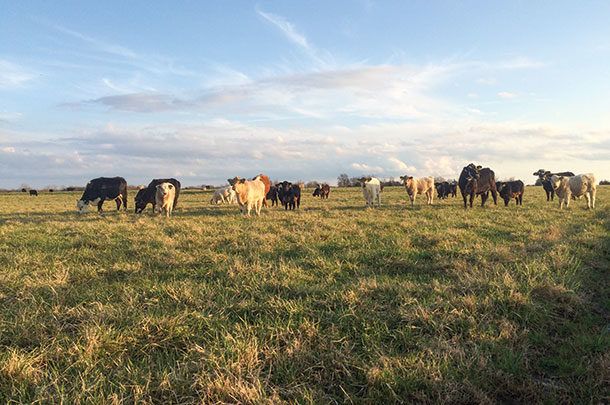You read that right, they fed no hay to their 800-plus head of cattle. Jane Parish, Mississippi State University Research extension professor, implemented the 300-Day Grazing program at the 2,456-acre Prairie Research Unit, which is part of the Mississippi Agricultural and Forestry Experiment Station.
They decided to implement the 300-Day Grazing program designed by University of Arkansas forage specialist John Jennings, in an effort to maintain ground cover and reduce muddy pastures. Reducing labor, fuel and equipment repair costs were also drivers in the decision to reduce the reliance on hay. Historically, they fed hay from October through March.
“Pasture is the cheapest feed we have,” Jennings says. To help producers capitalize on this economical resource and reduce the need for hay feeding, Jennings developed a comprehensive intensive-grazing program called 300-Day Grazing, with the goal of limiting hay feeding to 65 days or less per year.
There are five essential steps to implementing the program:
- Conduct a forage inventory to determine base forages and periods of limited forage or gaps in forage availability.
- Identify management practices to increase seasonal grazing, such as rotational grazing, stockpiling, overseeding and fertilization strategies.
- Include complementary forages to address gaps in forage availability.
- Plan forage programs for the entire year.
- Monitor and adjust forage production, supplementation and stocking rates as needed.
Rotational grazing can increase forage availability by more than 50 percent when compared to continuous grazing. Simply implementing rotational grazing increases the management options available to producers including increased stocking rates, leader-follower grazing and stockpiling forages.
Producers can apply the 300-Day Grazing approach any time of the year and get started quickly by using temporary electric fences to create rotational pastures.
Jennings offers these seasonal tips for managing the system: “In the spring it is important to graze the cool-season forages close to allow summer forages to emerge.
Summer grazing strategies can include overseeding complementary warm-season annuals or legumes, and rotational grazing maintains forage quality and availability and also lessens the effects of drought.” He also encourages stockpiling forages to round out the program.
In August and September, pastures can be prepared for stockpiling for fall grazing. Stockpiled bermudagrass pastures maintain decent quality from October through December and allowing cattle to harvest standing forage can save an average of $20 per animal unit.
Fall planting of cool-season annuals provides high-quality pastures ideal for growing calves, heifer development and lactating cows, and can also be used to limit-graze dry cows through the winter.
The 300-Day Grazing program protocol is easily tailored to fit any operation. Roy Gene Britt, a cattleman from southwest Arkansas, has utilized rotational grazing for 20 years and tried stockpiling bermudagrass last fall with good results.

As a pilot test, he stockpiled 80 acres, 40 of which he grazed for two weeks with 240 mature cows and calves. He says, “I don’t do it by the book; the way my operation runs, by the book doesn’t work, so I do what works for me.”
Britt baled some of the stockpiled grass because he was concerned about the quality and his hay supply, but he says, “It cost me more to bale it than to graze it.” In this pilot test, stockpiling 40 acres afforded him 168 grazing days per acre.
Parish says, “It takes a change in mindset to make this happen. We set a goal of grazing from October through December without the supplementation of hay, but it worked so well we didn’t feed any hay this winter at all.”
 Parish shifted spending priorities from hay production to pasture production through fall fertilization and overseeding cereal rye, annual ryegrass and white clover into the existing base of bermudagrass and toxic endophyte-infected tall fescue. She also included monoculture pastures of cereal rye, annual ryegrass and wheat.
Parish shifted spending priorities from hay production to pasture production through fall fertilization and overseeding cereal rye, annual ryegrass and white clover into the existing base of bermudagrass and toxic endophyte-infected tall fescue. She also included monoculture pastures of cereal rye, annual ryegrass and wheat.
The cattle were grouped by production stage and age. One challenge was regrouping the pastures as stocking rate and forage availability necessitated. Cattle were rotated in intervals ranging from two days to as long as two weeks.
Typically, several groups were rotated three days a week and the different groups were rotated on different days based on forage availability and nutritional needs. Free-choice mineral was available in all pastures and whole cottonseed was hand-fed to the lactating and growing cattle several times per week.
Cattle were moved using ATVs and personnel on foot. Positive advantages to the intensive grazing management include cattle becoming more used to human interaction, and are more closely monitored, allowing for early intervention when health problems became evident.
The challenges included the necessity of good communication and additional planning. Parish had to communicate the goals of the 300-Day Grazing program clearly to her willing but skeptical beef cattle team, and they had to understand how the system was going to work. Although the seasoned crew was initially doubtful, in the end they saw the value and benefits of the system.
To be successful, graziers have to think at least four weeks ahead and have possible cattle rotations planned two to three rotations in advance to decide which pastures to rest and for how long.
Additional planning was important as Parish stockpiled certain pastures for fence-line weaning the fall calving herd; this was accomplished by pulling those pastures out of the rotation for a couple of weeks to allow forage mass to increase.
Monitoring forage conditions was essential to the success of intensive grazing. Good lane systems, low-stress cattle movement and gate placement were critical in making frequent rotation workable. Keeping bulls separated from the females by at least two fences was important – and still there was one bull that kept finding a way out.
Parish’s “back of the envelope” economics for this first year included significant savings in labor, hay, diesel fuel and tractor repairs; tentative estimates value these in the five-figures range. The savings from hay alone, with hay valued at $35 per bale, would total around $82,000, or around $100 per cow.
Additionally, the body condition score (BCS) for the fall calving herd was 5.8, which is an increase over their typical BCS of 5.3 this time of year. “It is very hard to harvest and store forage that is higher in quality than what a cow can harvest herself, so why rely so heavily on hay when growing forage is better and more economical?” says Paul Beck, University of Arkansas beef cattle nutritionist.
The better nutrition and higher BCS increased the pregnancy rate of their fall calving herd significantly to 94 percent. Parish says the muddy conditions usually kept their conception rates well below 90 percent for the fall herd, indicating the 300-Day Grazing program increased income from the benefits to the animal along with the cost savings from pasture management.
Parish is convinced that the 300-Day Grazing program is a valuable alternative to hay production for her producers. She says, “They have to try it. It will work differently for each system; 300 days is conservative for us and will easily work here year-in and year-out. I think we could push that envelope a little more in years like this and go 11 months without hay.”
Parish also says it doesn’t have to be an “all-or-nothing” proposition, asserting that producers could choose certain production groups to feed hay, such as dry cows in designated areas to contain the associated mud accumulation.
She says, “Mud is a huge problem here, affecting herd health, colostrum quality and energy expenditure; 300 days of grazing is worth the extra labor and planning if for no other reason than to mitigate the effects of the mud.” ![]()
Melissa Beck is a freelance writer based in Arkansas.
PHOTO 1: A fall calving herd grazes cool-season annuals in January at the Mississippi State University Prairie Unit. Photo courtesy of Dr. Jane Parish.
PHOTO 2: Cow-calf pairs are rotated onto fresh pastures in Britt’s 300-Day Grazing system. Photo by Melissa Beck.
PHOTO 3: Roy Gene Britt, an Arkansas cattleman, monitors first-calf heifers on cool-season annuals in a rotational grazing system. Photo by Melissa Beck.








